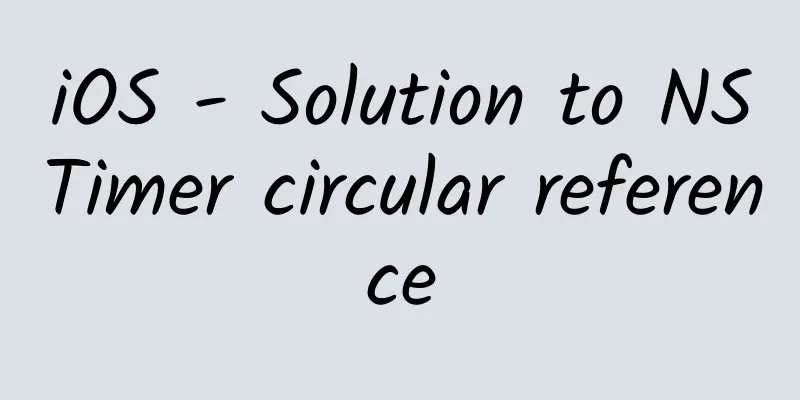iOS - Solution to NSTimer circular reference

|
Occurrence scenario In Controller B there is a NSTimer
You create it and attach it to the main runloop
Then when exiting Controller B, I forgot to turn off the timer. Controller B will not be released, and B and timer will have a circular reference because self is written directly into the timer when it is created. Method 1 Since we can't pass self directly, let's try passing weakSelf
The test result shows that a circular reference still occurs. B is not released, and timer has a strong reference to the weakSelf variable. Timer -> weakSelf -> B -> timer forms a circular reference among the three. Method 2 Set up a wrapper class, wrap Controller B and put it in the timer, like this I think Controller B is several MB in size, and leaking it is a waste of memory. WeakWrap is only a few hundred bytes, so it doesn't matter if it leaks. WeakWrap has a weak reference to Controller B. WeakWrap wraps Controller B and passes it into the timer. Even if you forget to turn off the timer, only WeakWrap and timer will be leaked. Theoretically, there are still memory leaks, but they are relatively rare. If a Controller is frequently entered and exited, one timer is lost every time it enters and exits. If there are dozens of leaked timers hanging on the main run loop, it will affect performance and smoothness. If you want dozens of timers to fire at the same time and call the timer event response method, the overhead is still quite large. Method 3 NSTimer is known to strongly reference the parameter target:self. If you forget to close the timer, anything you pass in will be strongly referenced. Just implement a timer. The function of a timer is to call a method at a fixed time. The calling time of NSTimer is not accurate! It is hung on the runloop and is affected by thread switching and the execution time of the previous event. Use dispatch_asyn() to execute functions at a fixed time. See the following code.
Dispatch_async loop does not generate recursive calls dispatch_async adds a task to the queue, and GCD calls back [weakSelf loop] This method solves the problem that the timer cannot be released and cannot be removed from the runloop. Using this method, I wrote a timer that does not have a circular reference. When the controller is released, the timer will also stop releasing automatically. You can even write self directly in the timer block without a circular reference. GitHub download address Method 4 I have never encountered the problem of circular references in NSTimer before, because I have always used them in pairs, opening them in viewWillAppear and closing them in viewWillDisappear. If they are not closed, so many timers mounted on the runloop will affect the performance and fluency. Just like managing memory, if the application and release are used in pairs, there will be no leakage. The principle of whoever applies should release. However, if the team is large, others may make mistakes and cause leakage, which can be solved from the technical point of view and the team programming standards. For example, some specifications are set, such as the controller must be successfully destroyed when exiting, and memory cannot be leaked. Self cannot be written in Block, etc. |
<<: When knowledge graphs “meet” deep learning
>>: Android resolution adaptation test
Recommend
Event planning: How to design an excellent event format?
Whether we are individual entrepreneurs or event ...
Video apps are leaving the online video market, and the living room is facing obstacles
Due to the intelligence of the operating system, ...
"How much is the salary for SEO in Lanzhou" How much is the salary in the SEO industry?
: : : : : : : : : : : : : : : How is the salary o...
A case study of low-cost customer acquisition optimization through auto show advertising!
When it comes to auto show advertising, experienc...
How to decompile Android APK
Preface I have been decompiling for a long time, ...
National Eye Care Day丨Share these eye protection tips with the ones you care about!
Today (June 6) is National Eye Care Day. Eyes are...
Will the new iPhone be made in India?
Perhaps in the near future, the words “Made in In...
Xue Song Behavioral Finance, Vol. 1
Xue Song's Behavioral Finance, Issue 1 Resour...
Xiaohongshu blogger’s guide to making money on Double Eleven!
The National Day holiday is over, and Double 11 i...
Event promotion: Free is the best strategy to attract new customers!
During this year's epidemic, in addition to v...
Why can domestic mobile phones occupy nearly half of the market share in India?
Not long ago, according to overseas media reports...
Understand brand communication in 3 sentences!
This article starts with the topic of communicati...
Subsidies will change, and the new energy vehicle market will be polarized
June 11 is the last day of the transition period ...
How to advertise on Google? Just 12 steps!
Google Ads is a pay-per-click (PPC) system that a...









